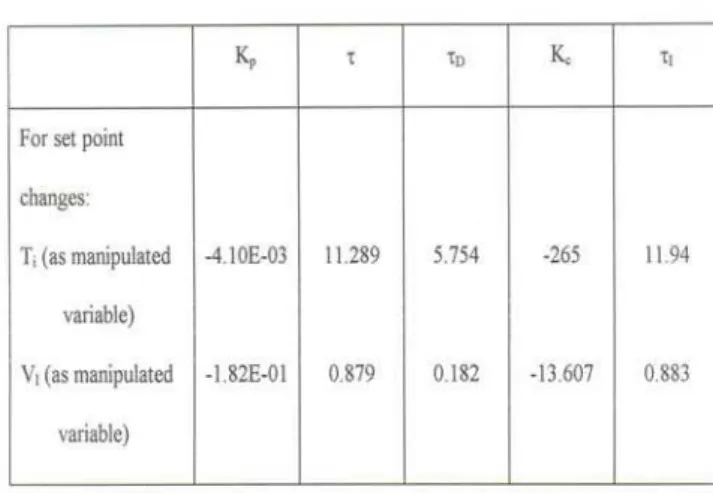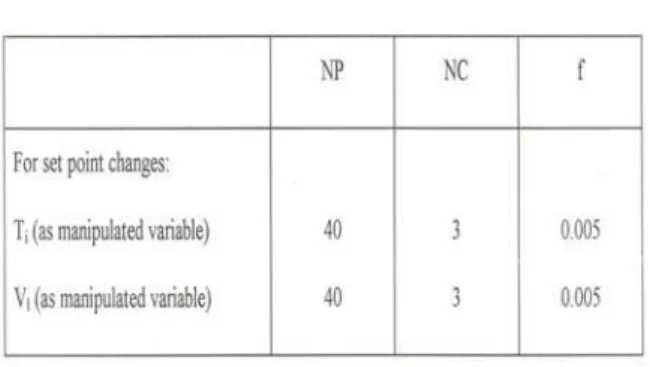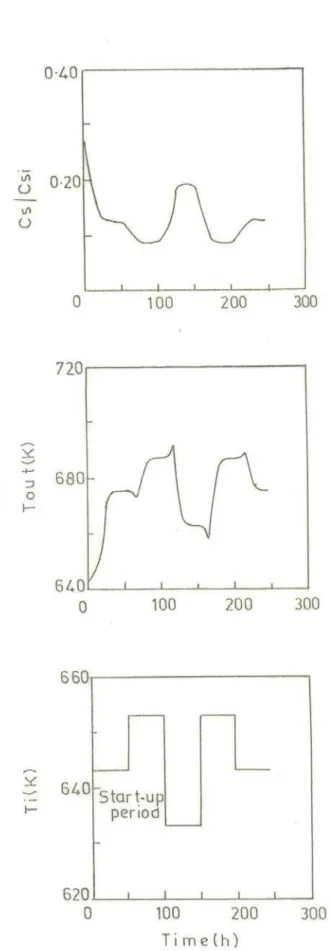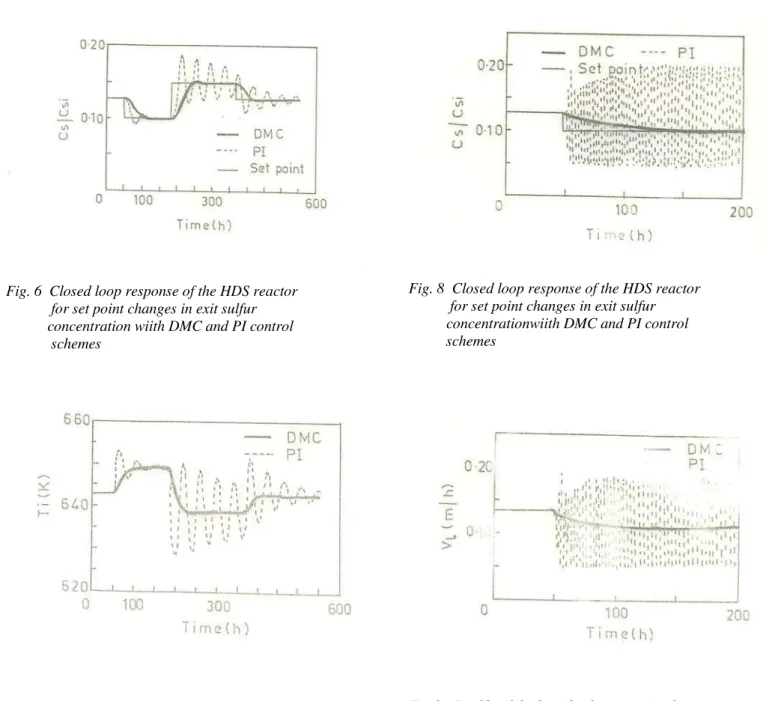Abstract— In the present study, the simulation studies on dynamics and control of a Hydrodesulfurziation (HDS) reactor are carried out in order to get proper insight into system behaviour under changes in the various input parameters namely inlet liquid temperature, liquid flow rate and inlet sulfur concentration. A dynamic model of the reactor is used for this purpose. The performance of a dynamic matrix control(DMC) is evaluated. It is found that DMC scheme gives satisfactory results for set point changes in exit sulfur specifications in comparison with a PI controller and important conclusions are also presented.
Index Terms— Hydrodesulfurization, Dynamics, DMC, Control
I. INTRODUCTION
Studies on dynamic behaviour of hyrotreating reactors are needed for process design, optimization and control. Trickle-bed reactors are employed for carrying out hydrodesulfurization reactions under adiabatic conditions. The published literature on dynamics, control and operability characteristics of these reactors is scarce[1-2]. Most of the reported theoretical studies are devoted to the understanding of hydrodynamics, catalyst wetting etc[3-4]. These theoretical models deal with steady-state performance with little emphasis on dynamic analysis[5-6]. In the present work simulation studies are carried out on a laboratoryscale adiabatic HDS reactor using the model proposed by Chao and Chang [2]. The model uses dispersed plug flow description of the phases and takes into account the energy balance. The orthogonal collocation method is used to obtain the solution of coupled transient mass and energy balance equations. The governing equations of the dynamic model and the solution procedure are presented in Appendix. Many control techniques using dynamic matrix have been developed and their industrial applications proved that they are suitable for chemical process control. In this simulation studies have been carried out on hydrodesulfurization process to compare the performance of DMC with conventional PI controller.
Manuscript received December 26, 2008
Priti Cicili is with the Dept. of Chemical Eng., University College of Technology, Osmania University,Hyderabad,-500 007,India.
G.Prabhaker Reddy is with the Dept. of Chemical Eng., Univrtdity College of Technology,OsmaniaUniversity,Hyderabad,-500 007,India. (e-mail: gpreddy_ouct@yahoo.com)
*V.Ramesh Kumar is with the Dept. of Chemical Eng., University College of Technology, Osmania University,Hyderabad,-500 007,India. (Phone : 91-40-27098901 Ext. 205; Fax:91-4027098472 e-mail:
rameshkumar@osmania.ac.in )
V. Ramesh Kumar is thankful to UGC and MHRD, Govt. of India for the financial support under TEQIP to present this work in ICCA-2009 in Hong Kong.
II. STEADY STATE AND DYNAMIC ANALYSIS
Under normal reactor operating conditions, changes in inlet liquid temperature, liquid flow rate and inlet sulfur concentration can significantly affect the bahviour of the process. The objective of this section is to study both the steady-state and transient effects of various input parameters on the behaviour of the reactor, which will ultimately result in the optimal operation of the reactor system.
A. Steady-State Behaviour
Steady-state solutions can be obtained by carrying the dynamic simulation asymptotically to the steady-state or by setting the time derivatives equal to zero in the ordinary differential equations and then solving the resultant nonlinear algebraic equations by trial and error. The convergence of the numerical scheme is strongly dependent on the initial guess values that are supplied. In the present study, collocation based Gauss-Newton method is used for the solution of the equations. The selected method has the observed merit of leading to convergent solutions for fixed initial guess values of the variables of
ψ
s= 0.1,ψ
v= 0.1,θ
= 0.1. Steady-stateaxial concentration and temperature profiles are presented in Fig. 1. The concentration profile shows reduction in % S along the axis of the catalyst bed. A maximum of 87.1% S removal is observed. The corresponding steady-state temperature profile shows a change in temperature (ΔT) from inlet to outlet of 32 K.
B. Dynamic Behaviour
Figure 2 shows the transient profiles along the bed at various dimensionless times. From startup it takes approximately 24 τ to reach the steady-state. A maximum of 87.1% desulfurization is observed and a maximum T of 32 K is noticed. Once the system reaches steady-state (precisely at 40 τ), step changes in inlet temperature, oil federate, sulfur feed concentration are given individually and the dynamic response of the system is studied.
C. Study of Influence of Various Input Conditions Step Change in Inlet Liquid Temperature:
The initial reactor temperature is an important factor in influencing the transient profiles of the reactor at the start-up. The results of exit sulfur concentration and temperature for step changes in inlet temperature are shown in Fig. 3. From this figure it is observed that increase in inlet temperature leads to a decrease in product sulfur. The temperature profile show inverse response and is due to increased conversion in the entrance region of the bed.
Dynamic Matrix Control for HDS Reactor
For different positive and negative large and small step changes in inlet temperatures, the gain values are calculated. It is observed that though the calculated gain values remain same for both positive and negative step changes, they differ when the magnitude of step is changed. So it can be concluded that the system exhibits nonlinear behaviour with respect to inlet temperature and one has to be very careful in control system design.
Step Change in Liquid Velocity:
Figure 4 shows the response of exit sulfur concentration and temperature profiles to different step changes in liquid velocity. The corresponding exit temperature profile shows overshoot. For different step changes in inlet liquid velocity, the gain values almost remain same. The system can be treated as linear with respect to changes in liquid velocity. Step Change in Inlet Sulfur Concentration:
Figure 5 shows the exit sulfur concentration and temperature profiles for different step changes in inlet sulfur content. During initial periods after the step change is introduced, a small increasing peak is observed and then the concentration falls exponentially. Calculated gain values are similar for different positive and negative step changes but differ when the magnitude of the step is changed. Therefore the system exhibits nonlinear behaviour with respect to inlet sulfur content.
III. CONTROL STUDIES OF THE REACTOR SYSTEM The controller objectives is to keep the exit sulfur concentration at desired set point. The inlet sulfur content is taken as main disturbance to the system. The inlet temperature or liquid flow rate can be the manipulated variables. In this part of study, the main objective is to compare the performance of a model based controller (DMC) with a conventional PI controller. In order to synthesis the control algorithm the response to step changes in initial temperature, liquid flow rate and inlet sulfur content are represented by first-order plus time delay (FOPTD) models:
1
)
(
=
Ke−s+p s d
s
G
τ τ(1) Where K is the steady-state gain, τP is the time constant
and τd is the dead time. The values of K, τP and τd are
obtained from the process reaction curve[7].
τP = 0.67 (t2-t1) (2)
τd = 1.3 t1 – 0.29 t2 (3)
where t1 is time at 35% of the ultimate response t2 is time at
85% of the ultimate response
A. Synthesis of PI Controller
The controller settings are obtained using ITAE criterion [8] for set point changes and given in Table 1.
Table 1 Evaluation of PI Controller settings
B. Dynamic Matrix Control
Dynamic matrix control strategy uses a time domain step response model (convolution model) of the process to calculate the “best” values of the future changes in the manipulated variables such that a performance index is minimized [9].
A step change in inlet temperature is given and the response in exit sulfur concentration is obtained. From this open-loop response curve, the step response coefficients (bi,
i=1, NP) are identified. The predicted value of the output, at ith step in the future can be calculated as
[
]
(
)
oldNP k
k k k i meas
o i
OL
Y
b
b
m
Y
∑
+ −
= +− −
Δ
−
+
=
11
1 1 ,
(4) Where the
Δ
m
oldis the old changes in the manipulated input. The response due to this old input changes can also be called “open loop response”The change in final control move is given by
( )
Δ
m
new=
(
A
TA
+
f
2I
)
−1A
Ty
(5)where A is NP x NC matrix with coefficients
a
ik=
b
i+1−K (6)and f is the weighting factor. The closed loop response is given by
∑
=
Δ
+
=
NCk
new k ik i
OL i
CL
Y
a
m
Y
1 ,
,
(
)
Table 2 DMC Parameters
IV. RESULTS AND DISCUSSION
A. Set Point Changes (Inlet Temperature is Manipulated Variable)
The closed-loop response of the exit sulfur concentration (set point) with DMC and conventional PI control schemes are simulated and shown in Fig. 6. The corresponding inlet temperature Ti manipulations are shown in Fig. 7. It is
observed that, DMC scheme performs smoothly with no overshoot and offset. Also DMC scheme has smooth manipulated variations. The response of PI controller is oscillatory and it takes very long times to reach the desired set point.
B. Setpoint Changes (Liquid Velocity is Manipulated Variable)
Figures 8 and 9 show the closed loop response of exit sulfur concentration (set point) obtained with DMC and PI schemes. From the curves it is observed that the PI-Controller fails to reach set point and shows oscillatory behaviour. This is because controller parameters are obtained using FOPDT model, which has partially represented the step response data. However, the DMC scheme gives satisfactory response. Looking at the manipulated variable also, DMC scheme behaves smoothly.
V. CONCLUSIONS
A reported mathematical is used to stimulate the dynamic behaviour of a laboratory adiabatic HDS reactor for step changes in inlet temperature, liquid velocity and inlet sulfur concentration. The transient profiles of temperature and inlet sulfur concentration indicated that the system exhibits nonlinear behaviour. The high inlet temperature increases the desulfurization efficiency, but results in higher bed temperature distribution along the axis of the catalyst bed. This can affect the activity of the catalyst. The increase in liquid velocity reduce the desulfurization efficiency suddenly but variation in temperature distribution along the axis of the catalyst bed is small. The increase in inlet sulfur concentration showed detrimental results. Though the increase in inlet sulfur concentration increases the desulfurization efficiency, a maximum rise in bed temperature occurred due to release of large quantities of reaction heat, which is a very harmful operation mode. The performance of dynamic matrix control is simulated and
compared with conventional PI controller. It is found that DMC scheme gives satisfactory results for set point changes in exit sulfur specifications while PI controller gives oscillatory and takes longer times to reach set point.
APPENDIX
SUMMARY OF AN ADIABATIC HDS REACTOR
MODEL EQUATIONS [2] Assumptions:
• The main reactions HDS, HDM occur within the porous catalyst particles
• The reactor operates adiabatically
• The flow pattern is described by the axial dispersed plug flow with independently specified dispersion coefficients for mass and heat. The radial dispersion effects of mass and heat are negligible.
• Resistances to transport of mass and heat between the external fluid phase and particle surface are neglected. • The fluid velocity, density and axial dispersion
coefficients are taken to be independent of axial distance and temperature.
Mass balance for external fluid phase:
ψ
ψ
ψ
ψ
ψ
ε
ε
θ δ h s 2 fs ) + (1 -ns s 2 s 2 ems s c l)
E
(
e
R
-z
-z
P
1
=
t
)
(
s∂
∂
∂
∂
∂
∂
ψ
ψ
ψ
ψ
ψ
ε
ε
θ δ h v 2 fv ) + (1 -nv v 2 v 2 emv v c l)
E
(
e
R
-z
-z
P
1
=
t
)
(
v∂
∂
∂
∂
∂
∂
z
P
1
-=
)
t
(
z
P
1
-=
)
t
(
0
=
z
At
v emv v v s ems s s +∂
∂
′
∂
∂
′
ψ
ψ
ω
ψ
ψ
ω
0
=
z
0
=
z
1
=
z
At
v s-∂
∂
∂
∂
ψ
ψ
Heat balance for external fluid phase:
)
E
e
R
-z
-z
P
1
(
)
+
+
(
=
t
s hREFERENCES
[1] T.Y Yan, , “ Dynamics of a trickle-bed hydrocracker with a quenching system., Can J Chem Engg., 48, 1980, pp 259-266.
[2] Y.C. Chao, and J..S. Chang Dynamics of a residue hydro- desulfurization trickle-bed reactor system”, Chem Eng Comm., 56, 1987,pp . 285-309
[3] M.H. Al-dahan, and M.P. Dudukovic, “Catalyst wetting efficiency in tricklebed rector at high pressure, Chem Eng Sci, vol 50, 1995, pp2377-2389.
[4] W. Garcia and J.M. Pazos “Hydrodynamics effects in trickle bed laboratory reactors for hydrodsesulfurization and hydrodemetalization of heavy feeds”, Chem Eng Sci, vol 37(10), 1982, pp1589-1591. [5] Y.T. Shah and J.A. Paraskos, ”Criteria for axial dispersion effects in
adiabatic trickle-bed hydroprocessing reactors”, Chem Eng Sci., vol 30, 1975, pp1169-1176.
[6] W Dohler and M Rupp, “Comparison of performance of an Industrial VGO treaters with reactor model prediction”, Chem Eng Tech., vol 10, 1987, pp 349-352.
[7] K.R. Sundaresan and P.R.Krishnaswamy, “Estimation of time delay time constant parameters in time, frequency and laplace domains”, Can J chem. Engg, vol. 56, 1978, , pp257-262.
[8] C.A. Smith, and A.B. Corripio, , Principles and Practice of Automatic Process Control, Wiley, NewYork, 1985.
[9] W.L. Luyben, “Process Modelling Simulations and Control for Chemical Engineers”,McGrawHill, New York, 1990.
Fig. 1 Steady state sulfur concentration and Temperature profiles.
Fig. 2 Bed temperature and sulfur concentration Profiles from startup to steady state
Fig. 4 Transient response to different step changes
in the Inlet liquid velocity.
Fig. 6 Closed loop response of the HDS reactor for set point changes in exit sulfur concentration wiith DMC and PI control schemes
Fig. 7 Inlet temperature manipulations for setpoint changes in exit sulfur
concentration with corresponding DMC and PI control schemes
Fig. 8 Closed loop response of the HDS reactor for set point changes in exit sulfur concentrationwiith DMC and PI control schemes




